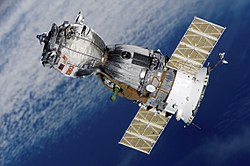 | |
| Operator | Roscosmos |
|---|---|
| COSPAR ID | 2006-009A |
| SATCAT no. | 28996 |
| Mission duration | 182 days |
| Spacecraft properties | |
| Spacecraft type | Soyuz-TMA 11F732 |
| Manufacturer | Energia |
| Launch mass | 7,270 kilograms (16,030 lb) |
| Crew | |
| Crew size | 3 |
| Members | Pavel Vinogradov Jeffrey Williams |
| Launching | Marcos Pontes |
| Landing | Anousheh Ansari |
| Callsign | Carat |
| Start of mission | |
| Launch date | March 30, 2006, 02:30 UTC |
| Rocket | Soyuz-FG |
| Launch site | Baikonur 1/5 |
| End of mission | |
| Landing date | September 29, 2006, 01:13 UTC |
| Landing site | Kazakhstan |
| Orbital parameters | |
| Reference system | Geocentric |
| Regime | Low Earth |
| Perigee altitude | 200 kilometres (120 mi) |
| Apogee altitude | 241 kilometres (150 mi) |
| Inclination | 51.67 degrees |
| Period | 88.64 minutes |
| Docking with ISS | |
| Docking port | Zarya nadir |
| Docking date | 1 April 2006 04:19 UTC |
| Undocking date | 28 September 2006 21:53 UTC |
| Time docked | 180d 17h 34m |
 From top to bottom: Jeffrey Williams, Marcos Pontes and Pavel Vinogradov. Soyuz programme (Crewed missions) | |
Soyuz TMA-8 was a Soyuz mission to the International Space Station (ISS) launched by a Soyuz FG launch vehicle.




